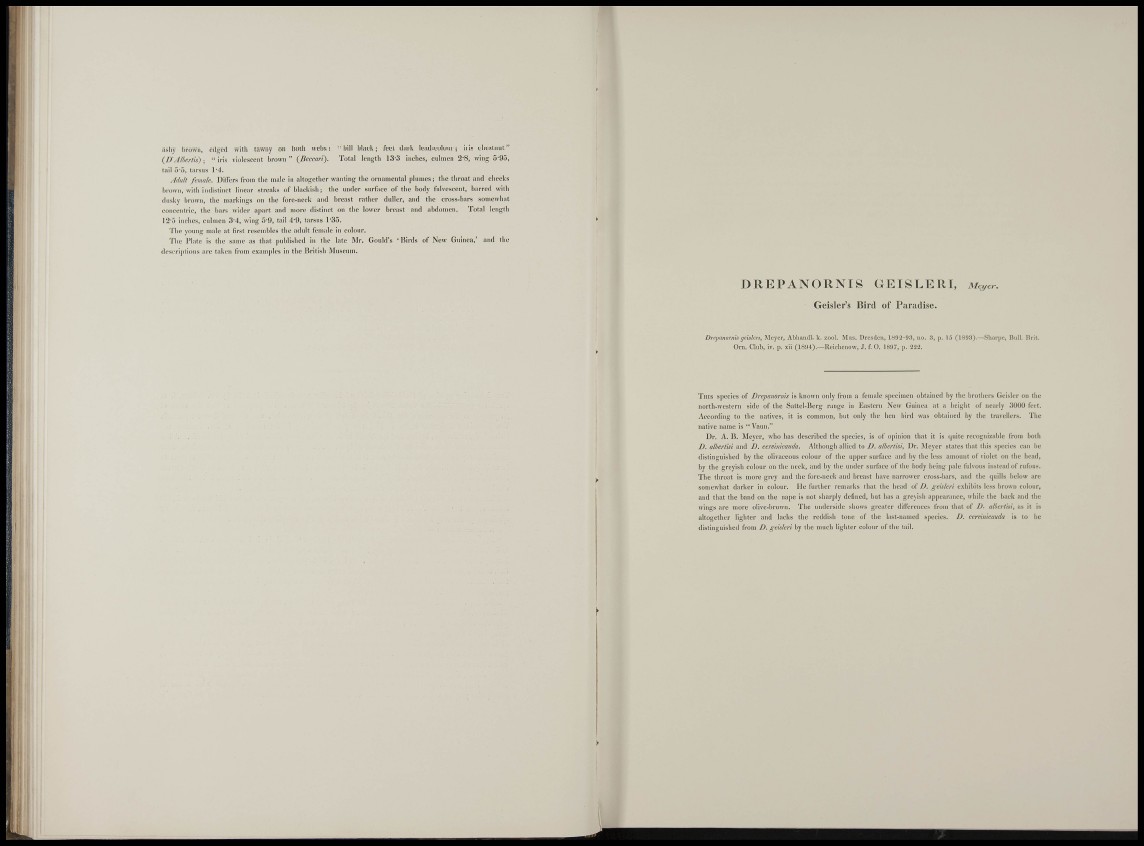
ff •• i
I!
witli tawny on
violescent brown
l)Otli webs :
" (Becc/iri).
" b i l l black; feet dark lead-colour; iris cliestnut"
Total lengtb 13-3 inches, culmen 2'8, wing 5-95,
asliy brown, ed^cd
{/)'/Il/ierlis} ; " iris
tail tarsus
AMt femule. DilFcrs from tbe male iu altos'etlier wanting the ornamental plumes; tlie throat and checks
brown, witli indistinct linear streaks of blackish; the under surface of tlie body fidvcscent, barred with
dusky brown, the markings on the forc-neck and breast ratlier duller, and the cross-bars somewhat
concentric, the bars wider apart and more distinct on the lower breast and abdomen. Total length
12-Ó iuclies, culuien 3 4, wing ñ'O, tail 4-Í), tarsus 1'35.
The young male at first rcscml)les the adult female in colour.
The riate is the same as that published in ihe late Mr. Gould's 'Birds of New Guinea,' and the
descriptions arc taken from examples in the British Museum.
DREPANORNIS GEISLERI, ^%er.
Geisler's Bird of Paradise.
Drepanornis ¡jeislen, Meyer, Abhandl. k. zool. Mus. Dresden, 189'2-9:3, no. 3, p. 15 (189.')).—Sharpc, ISull. lirit.
Orn. Club, iv. p. xii (1894).—Rcichcnow, J. f. 0 . 1897, p. 222.
Ill'
Tins species of Drcpamrnis is known only from a female sjiccimen obtained by the brothers Geisler on the
iiorth-westcrn side of the Sattel-Bcrg range in Eastern New Guinea at a height of nearly .'jOOO feet.
According to the natives, it is common, hut only the hen bird was obtaijied by the travellers. The
native name is " Vauu."
Di'. A. B. Meyer, who has described the species, is of oi)inion that it is cjuite recognizable from both
D. albertm and D. ceremicauda. Although allied to D. atberdsi, Dr. Meyer states that this species can be
distinguished by the olivaceous colour of the upper surface and by the less amount of violet on the head,
by the greyish colour on the neck, and by the uTider surface of the body being ])ale fulvous instead of rufous.
The throat is more grey and the forc-ncck and breast have narrower cross-bars, and the cpiills below are
somewhat darker in colour. He further remarks that the bead of D. gehleri exhibits less hrown colour,
and that the band on the nape is not sharjily defined, but has a grejish appearanec, while the back and the
wings are more olive-brown. The underside shows greater differences from that of O. albertm, as it is
altogether lighter and lacks the reddish tone of the last-named sjjecies. D. cermnicauda is to be
distinguished from D. gehleri by the much lighter colour of the tail.
Nt